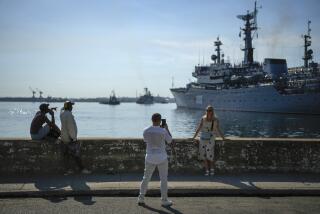Soviets Sailing Into Freedom-of-Speech Display
- Share via
As three Soviet navy ships sail into San Diego Harbor today for an unprecedented visit to the West Coast, a flotilla of Greenpeace vessels will greet them with banners and chants, while various political groups, flyers in hand, await their arrival ashore.
Welcome to America.
“It’s just a way of life in the United States--people have a right to their own opinions and a right to voice them,” said Cmdr. Doug Schamp, a Navy spokesman. “As long as they don’t interfere with the Soviets’ right to go to the zoo, I don’t have a problem with it at all.”
The 850 Soviets are not likely to be disturbed by the protesters, said Capt. Nicholai Ilyashenko, the naval attache with the Soviet Embassy in Washington.
“It’s their right to demonstrate, and I don’t think it will bother our sailors,” Ilyashenko said.
Today, the first day of the Soviets’ five-day visit, will be as American as officials can make it. While the guests will be greeted by protesters even before they set foot on U.S. soil, they will have the afternoon to picnic on the beach and to shop at Horton Plaza.
The Navy-to-navy visit, billed as an opportunity to foster good will and understanding between the two nations, has been perceived as an ideal platform to grab attention and pitch political messages. And officials from many groups say they will follow the Soviet guests wherever they go.
Although Greenpeace officials say they plan to take to the seas with banners and flags, John Birch Society members will stay ashore, hoping to hand out 10,000 flyers blasting the Soviet guests.
“To allow the ships here, we feel, supplies legitimacy and credibility to the Soviet government. We still feel they are oppressing their subjects,” said David Morris, regional director of the John Birch Society. “They are making cosmetic changes. There are no real changes. Allowing this visit sends out a message that we go along with it and we support them, which is wrong.”
Officials with Greenpeace, along with those from other environmental and peace groups, are planning protests in which the medium will be as varied as the message is constant: nuclear disarmament.
Using three rubber boats, Greenpeace members will escort the three naval warships as they enter San Diego Harbor this morning, said Karen Topakian, the disarmament campaign coordinator with Greenpeace. The groups also plan to use “mobile billboards” and distribute flyers at the activities Soviet sailors participate in this week.
“Steps toward naval nuclear disarmament must be taken by both governments,” said Brian Hinman, Greenpeace’s Nuclear Free Seas coordinator.
Officials from other groups, such as the Baltic American Freedom League and the Lithuanian American Community, also said they see the unique visit as an opportunity to press their political causes.
Carol Jahnkow, executive director of the San Diego-based Peace Resource Center, said the thawing relations posed by glasnost are not adequately reflected in the two nations’ weaponry.
“The approximately 14,000 naval nuclear weapons still in the world continue to pose not only a grave danger to us and the environment but are expensive relics of an outmoded and ridiculous approach to international relations that emphasizes massive annihilation,” Jahnkow said.
The three Soviet ships will carry no nuclear weapons. The visit is the second round in an exchange program established by Adm. William Crowe, former chairman of the U.S. Joint Chiefs of Staff, and Marshal Sergei Akhromeyev, former Soviet chief of staff.
Last July, the Soviet navy visited a U.S. naval base in Norfolk, Va., and, the following month, the U.S. Navy sailed to Sevastopol in the Crimea. This year’s exchange will be completed when the U.S. Navy sails to Vladivostok in September.
More to Read
Sign up for Essential California
The most important California stories and recommendations in your inbox every morning.
You may occasionally receive promotional content from the Los Angeles Times.













